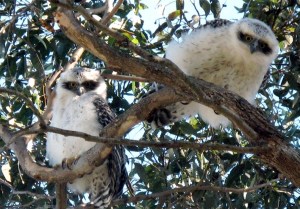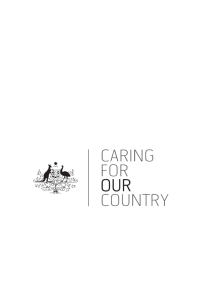Ninox strenua
A skilful predator that depends on our oldest trees for survival
Conservation Status
Vulnerable species in New South Wales (Threatened Species Conservation Act). At a national level it is classified as rare.
What does it look like?
 This deft hunter is Australasia’s largest owl. Its staring yellow eyes contrast dramatically with dark, greyish-brown plumage on its upper body, speckled with cream coloured bars. Its underbody is white with dark V-shaped markings. Its head is covered with distinctive white or pale brown plumage, with dark brown patches above the eyes. Juvenile Powerful Owls wear a beautiful white ‘crown’, with white plumage streaked with brown on their breast and belly. The beak of the Powerful Owl is short and hook-like. Adult Powerful Owls reach up to 60cm in length, with a wingspan of 140cm. They can weigh up to 1.45kg.
This deft hunter is Australasia’s largest owl. Its staring yellow eyes contrast dramatically with dark, greyish-brown plumage on its upper body, speckled with cream coloured bars. Its underbody is white with dark V-shaped markings. Its head is covered with distinctive white or pale brown plumage, with dark brown patches above the eyes. Juvenile Powerful Owls wear a beautiful white ‘crown’, with white plumage streaked with brown on their breast and belly. The beak of the Powerful Owl is short and hook-like. Adult Powerful Owls reach up to 60cm in length, with a wingspan of 140cm. They can weigh up to 1.45kg.
It’s hard to believe, but the Powerful Owl is the only owl that actually hoots, rather than screeches. You may hear the Powerful Owl calling at any time of the year, but especially in March and April as their winter breeding season approaches. Listen closely for a deep, resonant ‘woo woo’ or ‘wu whoo’. They will always give a double hoot, with the female owl’s voice at a higher pitch. But the male is the one who hoots more frequently; he is defending his territory from other owl pairs!
By May, things have quietened down. And if you listen closely in June and July, you may hear the female owl calling softly to her mate from within her nesting hollow.
Where does it live?
The Powerful Owl is found in eastern and south-eastern mainland Australia. In New South Wales, you will find the Powerful Owl in eastern forests from the coast to tablelands. In general, its populations are dwindling. It is rare to find many owls living in any particular area. Fortunately, records of Powerful Owls have increased over the past decade in the Sydney basin; it seems their populations might be recovering in this area.
The Powerful Owl needs to live in generous stands of forest. Each pair of owls settles in a large home range of between 400 and 1450 hectares. The ideal habitat for the Powerful Owl is taller, wetter eucalypt forests. However, they will also use:
- Drier eucalypt forest
- Woodland
- Riparian habitat (beside rivers and streams)
- Rainforest
During they day, the Powerful Owl seeks refuge in dense vegetation. Its favorite roost trees have a thick canopy, such as turpentines, she-oaks and rainforest trees. Preferably these roosts will be in a secluded gully, rather than on a high ridge.
What does it eat?
True to its name, the Powerful Owl is a strong and skilful hunter. By night, it swoops silently between the trees, seeking out medium sized, tree-dwelling marsupials such as the:
- Greater glider
- Ringtail possum
- Sugar glider
In addition, birds and flying foxes are also important prey for the Powerful Owl. There are some clear regional differences in the diet of different owl populations. In higher areas, gliders are their main prey. But in southern New South Wales, the ringtail possum is more frequently on the menu!
In Pittwater, its main prey species is likely to be the common ringtail possum, followed by gliders, flying-foxes, terrestrial mammals, birds and insects. Most of the animals that the Powerful Owl preys upon need tree hollows and a layer of shrubs in their habitat. For this reason, these are very important features of any habitat in which the owl is hunting.
What is its life cycle?
Once a pair of Powerful Owls has bonded, they will be mates for life. They will stay within their large home range territory, repeatedly using their favorite hollow nesting trees. It’s crucial that the Powerful Owl pairs have access to these hollows, which are usually found only in the oldest, tallest eucalypts in a densely vegetated gully. Ideally, the nesting tree will be not only old, but wide, with a diameter of around at least 80cm at breast height. To reach this size, most trees need to be at least 150 years old!
From late autumn to mid-winter, the Powerful Owls will breed. The male owl roosts in a grove of around 20-30 trees. He stays a few hundred metres from the nesting tree, where the female sits on a clutch of two dull white eggs. Just over a month later, the eggs will hatch.
The fledgling owls take two years to become fully mature. They often stay with the parent owls until the next breeding season, and they may even delay the pair breeding again.
|
|
 |
What are the threats?
The Powerful Owl is facing some serious threats. These include:
- The loss of suitable forest and woodland habitat due to land clearing (this affects both their habitat and the populations of their prey species such as gliders)
- Changes in forest structure due to forest harvesting. In particular, the loss of hollow-bearing trees has a serious impact on the Powerful Owl.
- Disruption near its nest site, which affects the ability of the owls to raise their young
- Disruption caused by bushfires (including hazard reduction burns)
- Road kills (one has recently been reported killed on Mona Vale Road).
- Predation on baby owls by dogs, cats and foxes (cats are known to climb up to tree hollows to take the young of other large hollow-nesting birds).
What can we do to protect it?
There are a number of actions we can take to protect this remarkable bird. These include:
- Conserve our remaining bushland, especially large stands of native vegetation with hollow-bearing trees
- Preserve trees in urban areas that may be suitable habitat for the Powerful Owl
- Establish wildlife corridors
- Manage bushfires and hazard reduction burns appropriately
- Minimise disturbance at nesting and roosting sites
- Rehabilitate sick, injured or orphaned birds
- Keep cats indoors
- Educate the community about the Powerful Owl
The breeding period of the Powerful Owl is from May to October, when the young will fledge. During the breeding season, the male Powerful Owl roosts in a “grove” of up to 20-30 trees, situated within 100-200 metres of the nest tree where the female shelters. If the team disturbs or becomes aware of a roosting owl, the location should be noted and this communicated to the Trust. It may be necessary to work in another area of the project for a short time.
Outside the breeding season, Powerful Owls can be observed roosting in trees close to the creeks involved in this project. Care must be taken not to disturb Owls roosting close to work sites, especially by excessive noise. In consultation with the project coordinator, works may be avoided completely in areas where Owls are frequently seen, and diverted to another area.
Powerful Owls nest in large tree hollows (at least 0.5 m deep), in large eucalypts (diameter at breast height of 80-240 cm) that are at least 150 years old. Trees of this size and age need to be protected and recruitment of suitable replacement trees encouraged. Within Bidjigal Reserve the species that seem to be used by POWLs include Angophoras (Angophora costata) and red bloodwoods (Corymbia gummifera). The main prey species is the Common Ringtail Possum, which nests in communal dreys in dense vegetation, often in the riparian zone but also frequently in urban gardens and the interface. While some disturbance of this species may be impossible to avoid, steps should be taken to minimize this disturbance.
The altered hydrology of the drainage system surrounding and within Bidjigal means that flash flooding can be expected soon after any moderate to heavy rain. If rain occurs care should be taken to move out of the creek bed and ensure vehicles are not trapped on the southern side of the causeway across Blue Gum Creek. These sudden high flows also mean that the riparian area is frequently scoured by water, making the establishment of riparian plant species difficult and depositing weed propagules from elsewhere in the catchment. This should be considered if any planting is proposed. Long stem methods may be appropriate.




















 This deft hunter is Australasia’s largest owl. Its staring yellow eyes contrast dramatically with dark, greyish-brown plumage on its upper body, speckled with cream coloured bars. Its underbody is white with dark V-shaped markings. Its head is covered with distinctive white or pale brown plumage, with dark brown patches above the eyes. Juvenile Powerful Owls wear a beautiful white ‘crown’, with white plumage streaked with brown on their breast and belly. The beak of the Powerful Owl is short and hook-like. Adult Powerful Owls reach up to 60cm in length, with a wingspan of 140cm. They can weigh up to 1.45kg.
This deft hunter is Australasia’s largest owl. Its staring yellow eyes contrast dramatically with dark, greyish-brown plumage on its upper body, speckled with cream coloured bars. Its underbody is white with dark V-shaped markings. Its head is covered with distinctive white or pale brown plumage, with dark brown patches above the eyes. Juvenile Powerful Owls wear a beautiful white ‘crown’, with white plumage streaked with brown on their breast and belly. The beak of the Powerful Owl is short and hook-like. Adult Powerful Owls reach up to 60cm in length, with a wingspan of 140cm. They can weigh up to 1.45kg.